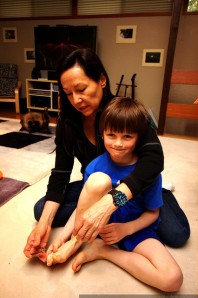From Our Bookshelf: Sensitive Sam
Sensitive Sam by Marla Roth-Fisch
 Sensitive Sam is the story of Sam, a young boy with sensory over-responsivity. He is more sensitive to the way things smell, sound and feel and has difficulty with daily life activities such as getting ready in the morning and playing at school. The book describes many of the sensations that Sam experiences as overwhelming. At times, the language can sound a little negative, but by the end of the book Sam works with an occupational therapist and discovers sensory diet techniques that help him tolerate the sensations inherent in his day. In the end, Sam concludes: Take it from me, Sensitive Sam, That things will be okay. By doing things a little differently, I can have fun EVERY day! Sensitive Sam would be an appropriate book for children who have sensory over-responsivity. They may feel alone in their experiences, and the book offers comfort that they are not the only ones who hate the feel of clay or the sound of a toilet flushing. We appreciate the author writing this story about a boy with sensitivities, as young boys may face more social stigma than girls with sensitivities. The book does not go into detail about the sensory diet activities Sam uses to help with regulation, but the book would be a great jumping off point for a family to discuss the sensory strategies that work for their child.
Sensitive Sam is the story of Sam, a young boy with sensory over-responsivity. He is more sensitive to the way things smell, sound and feel and has difficulty with daily life activities such as getting ready in the morning and playing at school. The book describes many of the sensations that Sam experiences as overwhelming. At times, the language can sound a little negative, but by the end of the book Sam works with an occupational therapist and discovers sensory diet techniques that help him tolerate the sensations inherent in his day. In the end, Sam concludes: Take it from me, Sensitive Sam, That things will be okay. By doing things a little differently, I can have fun EVERY day! Sensitive Sam would be an appropriate book for children who have sensory over-responsivity. They may feel alone in their experiences, and the book offers comfort that they are not the only ones who hate the feel of clay or the sound of a toilet flushing. We appreciate the author writing this story about a boy with sensitivities, as young boys may face more social stigma than girls with sensitivities. The book does not go into detail about the sensory diet activities Sam uses to help with regulation, but the book would be a great jumping off point for a family to discuss the sensory strategies that work for their child.


